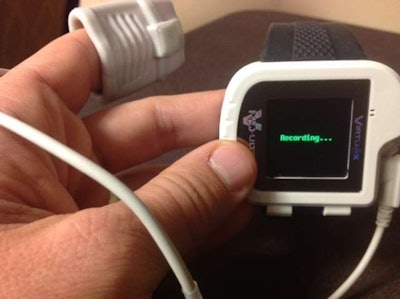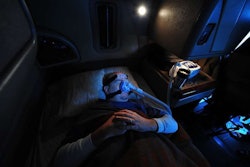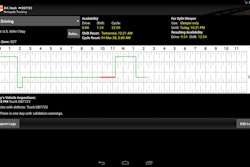 NASTC’s take-home screening test for sleep apnea is a take-home, one-night test with a small device worn like a wristwatch with another piece inserted on a finger. NASTC President David Owen spoke eloquently about the difference apnea treatment can make in someone who actually has a serious case of the condition. He was diagnosed himself 15 years ago and has been treated for the entire subsequent period.
NASTC’s take-home screening test for sleep apnea is a take-home, one-night test with a small device worn like a wristwatch with another piece inserted on a finger. NASTC President David Owen spoke eloquently about the difference apnea treatment can make in someone who actually has a serious case of the condition. He was diagnosed himself 15 years ago and has been treated for the entire subsequent period.The National Association of Small Trucking Companies has started offering both member and non-member carriers and drivers a sleep apnea screening and testing program that puts the process in the driver’s hands. “Where it belongs,” said NASTC President David Owen at a Friday, Nov. 7, session of NASTC’s annual conference in Nashville, Tenn. The session was devoted to the current apnea situation relative to driver medical certification, covered this summer in depth in Overdrive.
The problem NASTC’s program attempts to solve is the growing willingness of medical examiners to issue short-term conditional certifications — if any certification at all — pending results of a sleep study. The screening protocols used are various and sundry, as previously reported.
One common protocol, said Owen, only requires an affirmative answer to three of eight simple questions. The final three on the eight-question list doom many drivers to conditional certification pending an expensive sleep study, too often inordinately time consuming even to set up. “Number six,” Owen said: “Is the patient 50 years or older?” Number 7: Is the patient’s neck circumference more than 15.7 inches? And no. 8: Is the patient a male?
None of the 13 NASTC drivers of the year on hand for the conference would come through that questionnaire not needing an apnea screening, he added. The organization has been moving fast, given Owen believes he’s got two years from this past May to get out ahead of this issue for most of his member carriers’ drivers.
May 21 was the date the requirement for drivers to use doctors on the National Registry of Certified Medical Examiners went into effect. “A lot of drivers went out and got two-year medical cards before May 21” from their regular doctors to avoid any surprises from newly certified doctors, Owen notes. A lot of those doctors didn’t go through the process to get certified, but those who did received training on at least some protocol on screening for apnea in DOT physicals.
The NASTC program’s screen for drivers takes place when the company joins the program and, thereafter, for new-driver hires. Outside of the medical-certification process, drivers are offered “a simple $60 pulse-oximeter test,” participated in on a voluntary basis, said Owen. It’s a take-home, one-night test with a small device worn like a wristwatch with another piece inserted on a finger. “It’s a test for the oxidation level in the blood,” Owen added, which will show if drivers, during sleep periods, reach critically low levels indicative of apnea.
If the driver agrees to take the screen, the carrier pays for it and the data is uploaded to the program’s partner health practitioners, Dr. John McElligott — well-known throughout the trucking community and who is serving in a consulting role in the program — and a sleep specialist, both of whom review drivers’ screening data.
“They read the data — and here’s the very critical part,” Owen said. “They send the data, the letter and the report to the driver — not to me, not to FMCSA, not to the company owner. It goes to the driver,” establishing a direct relationship between the doctor and driver, outside of the medical certification process.
As a fleet, “if you’re on our apnea program,” Owen said, the screen “is not a qualification to drive for you, but if the driver declines to participate,” he/she “signs a piece of paper and it goes in his file that he chose not to take the test.” Participation by itself is bound to look good to federal investigators during an audit.
After the doctor-patient relationship is established, depending on results of the screening the driver may have no indication of apnea whatsoever or he/she may feel that a further test is in order. In the latter case, another wristwatch-type device taking further measures would be used to determine whether treatment is in order. NASTC, outside of the insurance industry, has low-cost, high-quality Continuous Positive Airway Pressure (CPAP) machines it’s prepared to offer to drivers actually needing treatment.
NASTC has done about 60-70 screens/tests to date and continues to “work out the bugs” in the program. All NASTC members currently utilizing the organization’s drug and alcohol program are eligible to be a part at no further cost but for individual tests. NASTC Director of Driver Health Skip Williams noted that, all told, program costs for an individual driver through screening and confirmation tests and actual CPAP purchase were, “for non-NASTC members, $1,400, less than $1,200 for NASTC members.” The bulk of costs were for the CPAP device itself, at $875.









